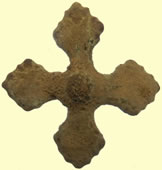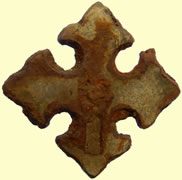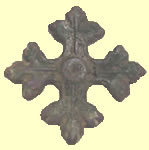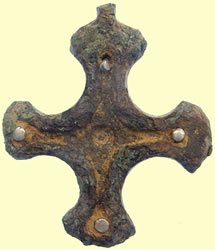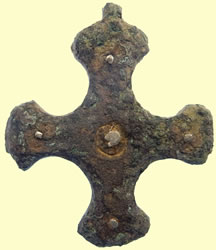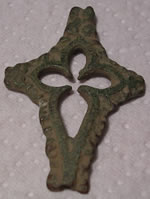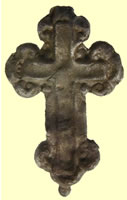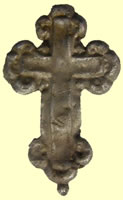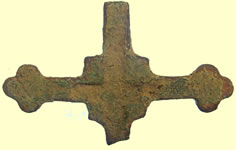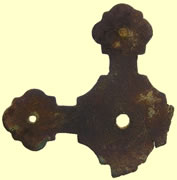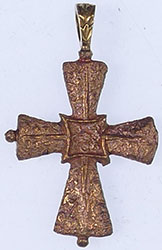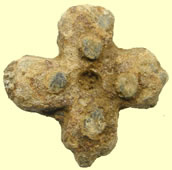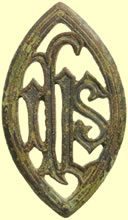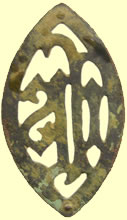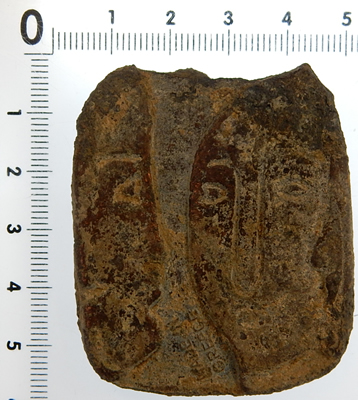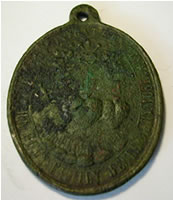

Metal detecting holidays in England with the World's most successful metal detecting club.20 years plus.
Twinned with Midwest Historical Research Society USA.
|
Religious
and Pilgrims items |
|||
Stunning medieval gold statue pendant - C13th judging by the Lombardic script on the scroll . This is probably to do with the Catholic church (DEI) and one of the members suggested FRCO is St Francis
Medieval gold figurine PAS no: ESS-49E265
Treasure Report: 2008 T581 A medieval figure of John the Baptist. The saint is shown not in his usual attribute of a camel skin, but in the robes of a prophet. He gestures with his right hand to a salver, which he holds in his left. This was originally designed to carry a lamb, signifying the Lamb of God. A scroll issues from the Saint’s left hand and is inscribed with the words The figure stands on a small plinth with a finished base. It is designed to be seen in the round and on its back there is a loop for attachment to an object. It would probably have been entirely enamelled, but no traces of enamel survive on the figure. The figure is gold and dates from the late fifteenth or early sixteenth century. Dimensions: height 33 mm, width 11 mm, depth 10 mm.
Consequently, in terms of age and as the object contains a minimum of 10% precious metal it qualifies as Treasure under the stipulations of the Treasure Act 1996.
|
|||
I wonder if you are able to assist.
|
|||
Pilgrim ampullae - holly water bottle made of lead 12th to 15thC,Mitchiner suggests that many ampullae were used in the annual springtime ’Blessing the Fields’ ceremony, in which the Holy Water they contained was sprinkled on the ground to give prayer for a good harvest. Having served this purpose, Mitchiner suggests that the ampullae were discarded. Others have suggested that the ampullae were buried along with their contents for a similar purpose.It seems to be part of human nature to want to retain some physical object as a connection with a special place or event. Pilgrims have always left for home with souvenirs. Sadly, in the past as today, some are selfish enough to chip away pieces of stones, shrines or statues. It was this sort of vandalism at Christian shrines that led to the appearance of the Medieval trade in pilgrims’ signs or tokens in the 12th century. Such signs, stitched to hats or cloaks, had practical value in offering genuine safe passage for pilgrims on their homeward journeys, even in times of war. They also gave prestige and proof that a person had actually done what they had set out to do. But, more than this, they were regarded as holy in themselves through having been in direct contact with the relics or tomb of a saint. Signs were used as amulets for protection on the way home and to bring healing and other blessings to pilgrims themselves and to their friends and families. They were often buried in fields or placed in wells to bring abundance or weed-free crops, and placed in the home as apotropaic devices. Healing remedies could be made by dipping signs in water or wine to be drunk. It was the shrine to St. Thomas Becket in Canterbury that made souvenir holy water containers popular. People have always gathered water from sacred springs and rivers, but this holy water, it was believed, contained an infinitesimal portion of the blood of the murdered bishop, thoughtfully gathered by the monks who discovered him. The water was believed to effect cures, and the practice soon spread to other shrines, although remaining a particularly English phenomenon. These containers, called ampullae, were usually small, flat, bag-shaped, lead vials. Filled with holy water at the shrine and touched to the saint’s tomb or relic, they were worn hung around the neck.
|
|||
East Anglian Type - IHC stands for Jesus Christ - 54.25g, 49.34mm H x 31.73mm W x 13.94mm T
|
|||
East Anglian type with shell design Pilgrim ampullae - holly water bottle made of lead 12th to 15thC, These ampoule were brought from pilgrimage places as a souvenir
12th -15thC Pilgrims lead ampullae - East Anglia type A flask-shaped pilgrim’s ampulla. One face has a scallop-shell design, a sign of pilgrimage
Medieval lead pilgrims ampullae with flower pattern. East Anglia type many made at Walsingham Double V, for Virgo Virginum, Virgin of Virgins, indicating Mary, Mother of God, and forming the W of Walsingham. (The VV symbol has also been used widely as an apotropaic device in house protection.) |
|||
Pilgrim ampullae - holly water bottle made of lead 12th to 15thC, Scallop shell type with merchant shield on reverse |
|||
Pilgrim ampullae |
|||
Pilgrim ampullae
Medieval lead pilgrims ampullae with flower pattern. East Anglia type many made at Walsingham Double V, for Virgo Virginum, Virgin of Virgins, indicating Mary, Mother of God, and forming the W of Walsingham. (The VV symbol has also been used widely as an apotropaic device in house protection.) Pilgrim ampullae - holly water bottle made of lead 12th to 15thC,
|
|||
Pilgrim ampullae - holly water bottle made of lead 12th to 15thC, The reverse face is convex and decorated with a compass-drawn four-petalled flower; each petal containing an internal linear rib. The obverse face is flat and is decorated with a shield in cast relief. |
|||
Medieval 'Norfolk type' lead Pilgrim's Ampullae - Fleur de lis and crown |
|||
Many ampullae used the pre-eminent pilgrimage symbol of the scallop shell, as with the Norfolk example . Although most closely linked to the shrine of St. James at Santiago de Compostela, the scallop was a symbol of renewal and regeneration before Christianity. Beginning with representations of Venus, it became commonplace in Roman architecture and on sarcophagi
|
|||
Medieval lead Papel BadgesPapal bullae are lead seals that were attached to papal documents to guarantee their authenticity. A bulla was attached to its document using a silk or hemp cord, threaded through the vellum and then passed through the bulla itself, from top to bottom. A new obverse die was made for each new pope, with his name in capital letters over three or four lines. A border of tiny pellets surrounded both obverse and reverse, in an attempt to deter fraud; any imitations would need to replicate the exact number of dots to avoid detection. Reverse dies showing the heads of St Peter and St Paul have been used since the time of Gregory VII (1073-85). Because of their standard format, they could be re-used by successive popes. The PAS’s two early-medieval bullae have lettering on both sides. A possible complication in the identification of bullae is the potential for examples issued by antipopes to be encountered. Political disputes over who was the ‘true’ pope led on occasion to the existence of two rivals for the title, the ‘antipopes’ being based at Avignon. Although bullae of antipopes are known, there are very few examples. The papal documents themselves (called ‘papal bulls’) included those that recorded grants or privileges. Because of this they could be kept for centuries to prove these rights. Bullae were also attached to more personal documents such as indulgences, which could make their way into graves (see below). How seals from these documents got into the ground is uncertain; mechanisms could include the accidental loss of personal amulets, a deliberate burial in graves or fields, or the deliberate destruction of papal documents at the Reformation.
|
|||
|
Mint condition lead document papal seal. Pope Boniface VIII (AD 1294 to AD 1303) BONI FATIVS Medieval Papal Bullae. A lead Papal Bullae of Pope Obverse shows the heads of the apostles Peter and Paul, the founders of the Church of Rome with SPASPE (Sanctus PAulus and Sanctus PEtrus) above
Medieval Papal Bullae. A lead Papal Bullae of Pope Obverse shows the heads of the apostles Peter and Paul, the founders of the Church of Rome with SPASPE (Sanctus PAulus and Sanctus PEtrus) above Rev ELIE STMVS PI III http://historymedren.about.com/library/who/blwwpopelist.htm 38.73mm, 44.13g http://www.newadvent.org/cathen/12272b.htm The reverse (verso) of the bulla shows the name of the Pope, which is written in the nominative, with his abbreviated title. It reads 'CELE / STINVS / PP • III' within a beaded border. The 'PP' has an 'Ω' above. This bulla has the name of Pope Celestine III on the verso. He was elected Pope in 1191 and continued until 1198.
1159 - 1181 AD Pope Alexander lead Papel badge -33.03 mm L |
|||
|
Medieval Papal Bullae. A lead Papal Bullae of Pope This bulla has the name of Pope Clement III 1187 -1191 AD Obverse shows the heads of the apostles Peter and Paul, the founders of the Church of Rome with SPASPE (Sanctus PAulus and Sanctus PEtrus) above Rev CLE/MENS/PP. III
The reverse (verso) of the bulla shows the name of the Pope, which is written in the nominative, with his abbreviated title. It reads 'CLE / MENS / PP • III' within a beaded border. The 'PP' has an 'Ω' above.
Medieval lead papal badges
Medieval pilgrim badges
Medieval pilgrim badge |
|||
Medieval badges Ref Mitchiner p244 939 - 941
Badge still in its plate before trimming
Circa 1485 - 1540 Sheet copper-alloy mount or badge of cross-crosslet shape; turned-over edges The reverse shows evidence of a central soldered attachment, which is now missing. |
|||
Crosses |
|||
Simply stunning chunky early medieval gold decorated bronze cross pendant - The gold pin decoration is very interesting as it probably riveted a central inlaid emblem which is now missing- one for the museum to play with 18.76g, 41.18 mm L x 6.73 mm T
|
|||
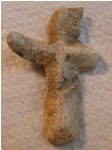 |
|
|
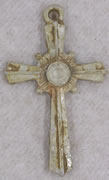 |
|
Medieval
lead cross |
17thC copper crucifix |
An incomplete copper alloy corpus (body of Christ) from a crucifix, of probable Medieval dating (AD 1300 to AD 1500). The cross, which the corpus would have been mounted on, is no longer present. Several similar corpuses have been recorded on the PAS database, including WMID-E91F61; ESS-33F627, PUBLIC-5B7BC3, LIN-D469A6, SF-F5F1D4, SWYOR-38D747, IOW-E2C385, WMID-7E0271, SWYOR-2D53D4, LIN-39DDE5 and LEIC-FAE965. |
20thC alloy cross |
Reliquary cross pendant of probable Late Medieval to Post Medieval date, about AD 1400 - 1600. |
|||
  |
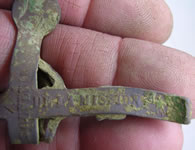 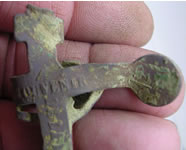 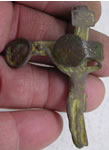 |
||
|
20th
C cross |
Victorian cross with inscription - DE LA MISSION (The mission) |
||
|
  |
||
| Medieval silver cross - similar construction to 13thC Knights templar badges 1.06g, 22.82mm | Crucifix. Flat straight-armed crucifix with an apical loop for suspension. Both sides bear motifs in stamped low relief. On one side is the crucified Christ, draped at the waist and haloed, with scroll above. The other side bears the motif of a rayed Eucharistic host and chalice, and the legend THY / KING / DOM /COME - from the Lord's Prayer - with one syllable on each of the four arms of the cross. The emphasis on the Eucharist and the kingship of Christ would probably make this a Roman Catholic or High Anglican piece; as Catholic devotion only became legal again in the 19th century a modern date is indicated. Suggested date: Modern, 1850-1950. |
||
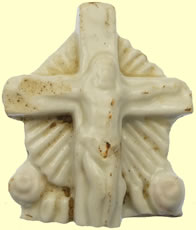 |
  |
||
| Post Tudor ceramic crucifix | 20thC cross | ||
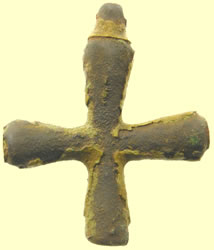  |
  |
||
Late medieval gilded cross pendant The object appears to be a Christian equivalent to the hammer pendants favoured by adherents of Thor, and is perhaps contemporary with such objects. Suggested date: Early Medieval, 800-950. |
A copper alloy crucifix pendant. There are raised moulded roundels on the face of the crucifix although they are apparently not settings or borders for any visible designs or inlays. Possibly these are imitations of pictorial roundels or other design elements found on larger church crucifixes. The reverse is undecorated. Circa 16th-17th century. | ||
A Modern cast copper alloy crucifix, probably dating to circa AD 1800-1900. The object is in the form of a cross with a moulded depiction of Christ on one face and Madonna with child on the opposing face. The depictions are mounted on a four-lobed cross with a large possible flower motif behind. Each arm of the cross terminates with a trefoil knop. The uppermost terminal also has an additional pierced circular projection, possibly this was so the crucifix could be worn as a pendant. Ref Unique ID: WMID-532B87
|
|||
A 17th-century copper-alloy crucifix; one face with Christ on the cross, on the other side is the Virgin Mary holding the Christ Child. The ends of the cross terminate in quatrefoils within which are letters.The heads of Christ and Mary are within the quatrefoils - these are surrounded by fleur-de-lis. The crucifix is worn and the top is broken where the suspension loop would have been, perhaps intended for a rosary. Similar example at National Museum of Scotland NMS KE8. |
|||
|
  |
||
A complete Medieval copper-alloy pendant in the form of a crucifix (c. 1300-c. 1500). The cross pattée has a suspension loop at the top. On the front is a moulded figure of Jesus nailed to the cross. The back has a moulded figure of Mary. This pendant is reddish brown. Ref Unique ID: IOW-706880 |
20thC silver crucifix | ||
 |
 |
||
| Crucifix fragment | Edwardian enamelled cross | ||
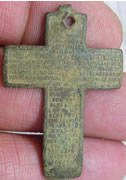 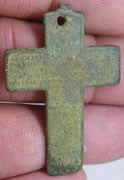 |
|
||
| Victorian copper cross | Cast copper-alloy crucifix, loop for suspension broken. The surface is decorated with moulded wreath foliage and the square panel in the centre bears a floral decoration. Date from: Circa AD 1700 Unique ID: LANCUM-B2ECA1 |
||
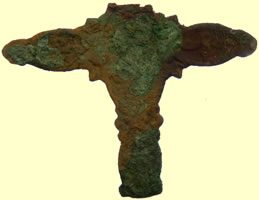  |
  |
||
| Post medieval crucifix | A cast copper alloy pendant, probably Modern. It is a crucifix, with an integral suspension loop located on the top. The cross has raised edges, creating a hollow in the pendant within which there are remnants of a copper alloy body of Christ; each of the three nails are visible, as is a portion of the left arm and the legs. Circa 1750 |
||
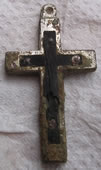 |
 |
||
| 1850- 1900 cross | Early medieval cross | ||
Medieval lead cross |
Medieval lead cross |
||
 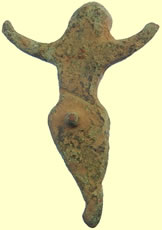 |
 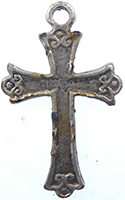 |
||
| Medieval crucifix mount | 20thC silver crucifix | ||
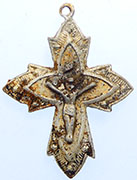 |
  |
||
| 20thC silver crucifix | 1850-1950 crucifix | ||
 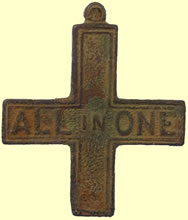 |
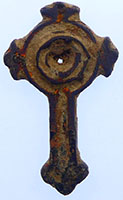 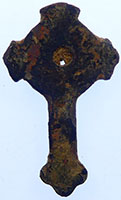 |
||
| Victorian cross | Medieval cross mount | ||
  |
|||
| Victorian silver crucifix | |||
Medallions/Pendants |
|||
15th/16thC religious pendant IHS: dating from the 8th c., this is an abbreviation for "IHESUS," the way Christ's Name was spelled in the Middle Ages (despite popular belief, the monogram stands neither for "Iesus Hominum Salvator" --"Jesus Saviour of Men" -- nor for "In His Service.") Popularized by St. Bernardine of Siena, the monogram was later used by St. Ignatius of Loyola as a symbol for the Jesuit Order. The IHS monogram is an abbreviation or shortening of Jesus' name in Greek to the first three letters. Thus ΙΗΣΟΥΣ, ιησυς (iēsus, "Jesus"), is shortened to ΙΗΣ (iota-eta-sigma), sometimes transliterated into Latin or English characters as IHS or ΙΗC. The symbol is said to appear rarely in the catacombs, only in the catacomb of Priscilla and the atrium of the Capella Gr�ca (Greek Chapel).1 It was popularized in the fifteenth century, however, by Franciscan disciple Bernadine of Sienna as a symbol of peace. In 1541 St. Ignatius Loyola adopted the symbol with three nails below and surrounded by the sun as the seal of the Jesuit order. Contrary to some authors, the monogram originally stood for neither for Iesus Hominum Salvator ("Jesus Savior of Men") nor for "In His Service." Some attribute its origin to Constantine's vision, where he saw a cross with the inscription "In hoc signo vinces" ("in this sign you shall conquer,"2 which is abbreviated, according to them, as IHS. However, this seems to require a stretch, as do claims that it is really a pagan symbol. The simplest explanation, as an abbreviation of Jesus' name, is best. |
|||
  |
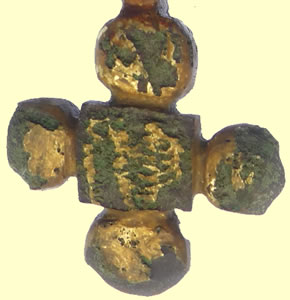 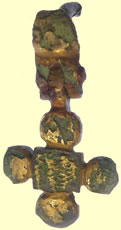 |
||
| Georgian Madonna of Pompeii silver framed enameled pendant 'Madonna di Pompeii' |
Late medieval gilded cross pendant The object appears to be a Christian equivalent to the hammer pendants favoured by adherents of Thor, and is perhaps contemporary with such objects. Suggested date: Early Medieval, 800-950. |
||
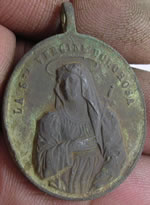  |
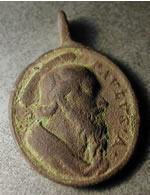 |
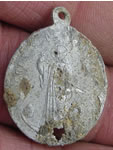 |
|
|
S.Vincenzo
Di Paolo
La Sza Vergine Dolorosa 'Way of the Cross ' |
19thC Pope
medallion PAVLVS.A |
20thC
Religious alloy medallion |
|
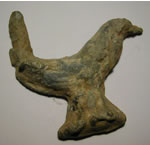 |
 |
 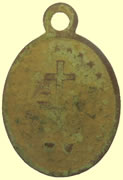 |
|
Pilgrims badge |
Pilgrims badge |
Religious
Pendant probably 19thC |
|
 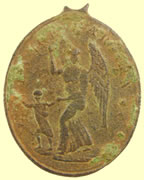 |
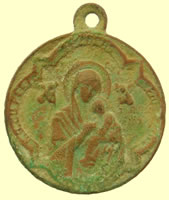 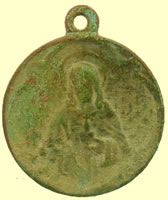 |
||
Georgian religious pendant |
Victorian religious medallion |
||
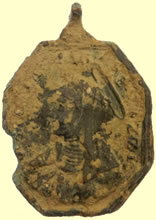 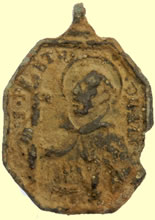 |
  |
||
Georgian religious pendant |
Victorian religious medallion |
||
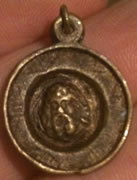   |
 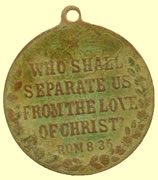 |
||
14thC John the Baptist medallion |
Victorian pendant
'God is our refuge and strength' 'Who shall separate us from the love of Christ'
|
||
20thC Greek sovenier religious plaque |
|||
 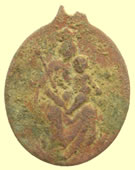 |
 |
||
| Victorian religious pendant | Excellent medieval religious mount - gold and red enamel remain |
||
 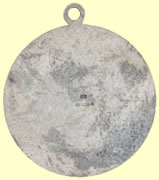 |
  |
||
20thC St Christopher silver pendant |
Medieval gilded cross fragment |
||
|
  |
||
| 18thC religious pendant | Georgian religious pendant | ||
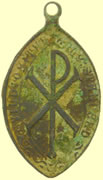 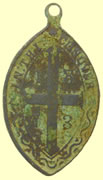  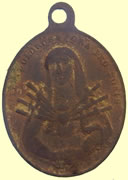 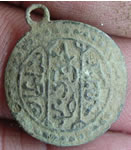 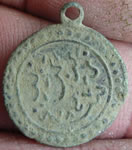
|
|||
| 19th/20th religious pendants | |||
  |
  |
||
| 1940's silver St Christopher pendant | Medieval cross pendant | ||
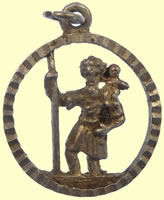 |
 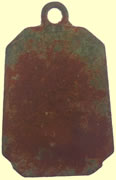 |
||
| 20thC St Christopher silver pendant | 20thC St Christopher pendant | ||
  |
  |
||
| 20thC St Christopher silver pendant | 20thC St Christopher silver pendant | ||
  |
  |
||
| 20thC St Christopher silver pendant | 20thC St Christopher silver pendant | ||
  |
  |
||
| 20thC St Christopher silver pendant | 20thC St Christopher silver pendant | ||
  |
  |
||
| 20thC St Christopher pendant | Medieval religious mount | ||
|
|||
Tiny Medieval Madonna and child figure 2.86g, 26.01mm A cast copper-alloy figurine depicting a female figure, probably the Virgin Mary, 26mm in height and of late medieval or early post-medieval (pre reformation) date. Traces of gilding remain, most notably on the back. The figure appears to be wearing a cowl with hood; the head is angled to the right and the feet to the left. The figure's left arm appears to be bent at the elbow and folded across the chest, but the right arm is incomplete. Two shallow cavities, one each side, at the base of the figure may represent attachment points. |
|||
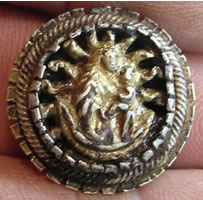 |
|||
| 572. Tendring Area, Essex: Post-Medieval silver hat badge (2006 T482) Date: Early 16th century Description: A circular hat badge, gilt front and back, with the remains of a pin on the back. The badge comprises a pinked backplate with thick cable decoration at the edge and a band of pinked decoration enclosing a built-up cast element at the centre with the Virgin and Child sitting on a crescent moon. There are sun rays behind the figures. Diameter: 19.9mm; weight: 6.54g. Discussion: The form and iconography indicate that this is a hat badge, as fashionably worn by men on the upturned flap of a hat around 1500–25. See for example a Crucifixion scene from Raydon, Suffolk (Treasure Annual Report 2003, no. 240), which indicates the original shape of the hook, i.e. with two sharp Ubends and sharp tip. Disposition: Colchester & Ipswich Museums Service. |
|||

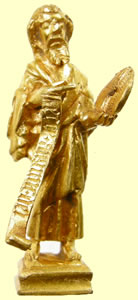
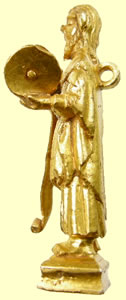
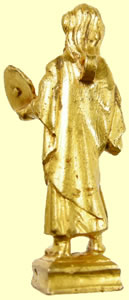


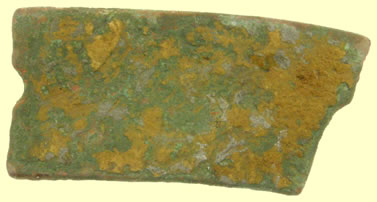


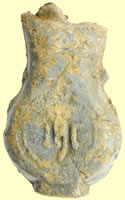


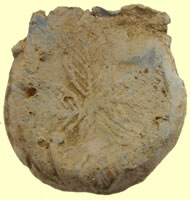
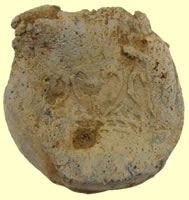




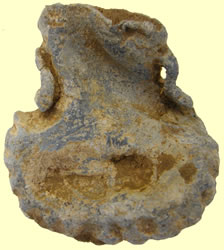
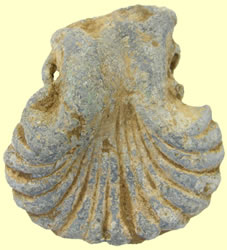


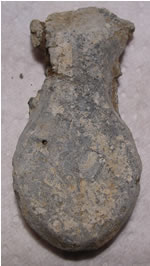
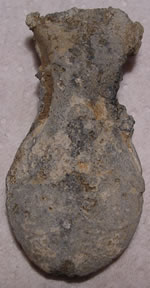
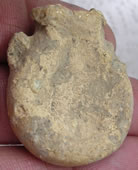














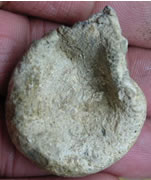
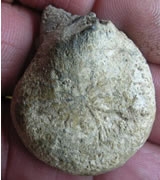
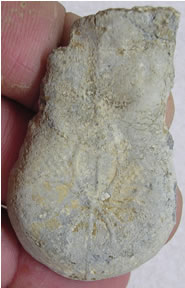
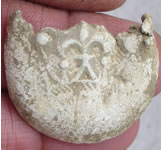
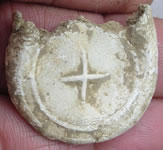
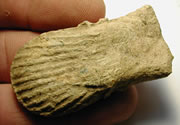

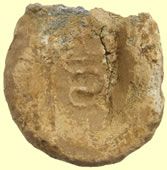





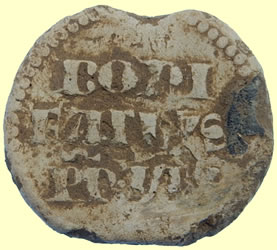
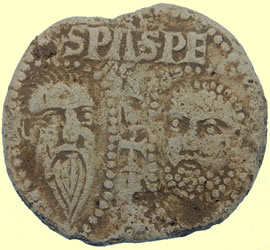


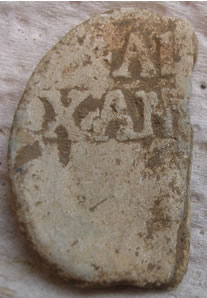
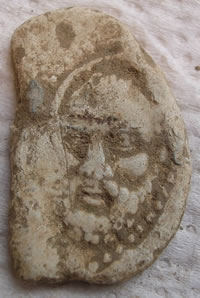
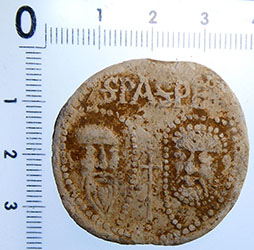
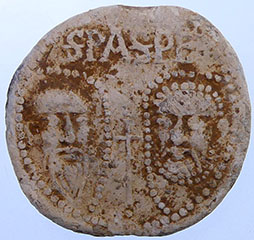
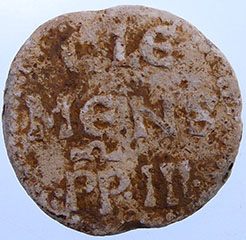


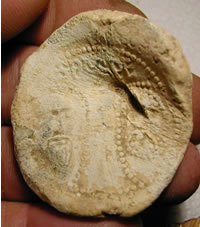


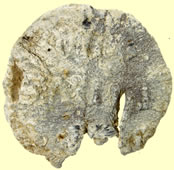










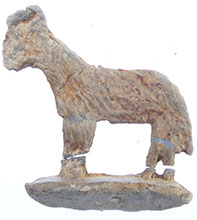
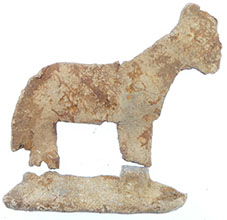
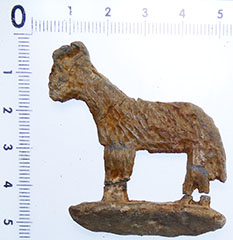
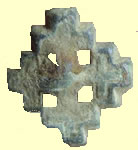

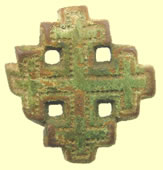

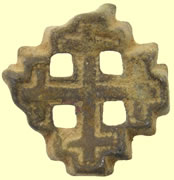
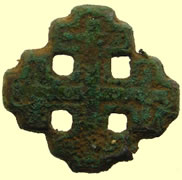
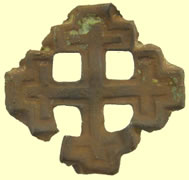

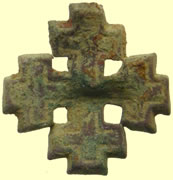
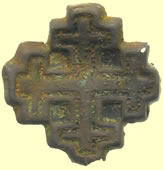


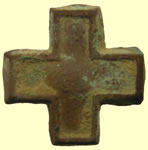



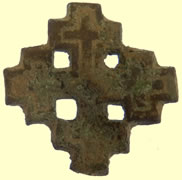


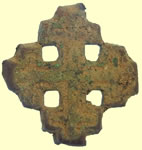








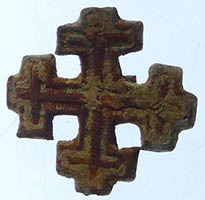



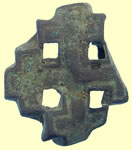
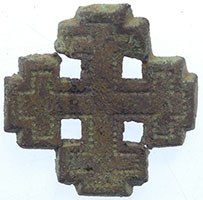
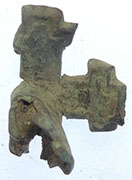



 'A badge for a Knight of the Order of the Holy Sepulchre in bronze and dating somewhere around C13/14th possibly very slightly later . This is a very scarce item and it relates to The Equestrian Order of the Holy Sepulchre of Jerusalem being a Catholic chivalric order of Knighthood that traces its roots to Godfrey of Bouillon, principal leader of the First Crusade. According to reliable sources in the Vatican and Jerusalem, it began in historical reality as a mixed clerical and lay confraternity (association) of pilgrims which gradually grew around the most central of the Christian holy places in the Middle East, the Holy Sepulchre or the tomb of Jesus Christ.This would have been a pin for a member of the order , there is a mark on the reverse where the original pin would have been fixed '
'A badge for a Knight of the Order of the Holy Sepulchre in bronze and dating somewhere around C13/14th possibly very slightly later . This is a very scarce item and it relates to The Equestrian Order of the Holy Sepulchre of Jerusalem being a Catholic chivalric order of Knighthood that traces its roots to Godfrey of Bouillon, principal leader of the First Crusade. According to reliable sources in the Vatican and Jerusalem, it began in historical reality as a mixed clerical and lay confraternity (association) of pilgrims which gradually grew around the most central of the Christian holy places in the Middle East, the Holy Sepulchre or the tomb of Jesus Christ.This would have been a pin for a member of the order , there is a mark on the reverse where the original pin would have been fixed '
